Copyright 2016 by McGraw-Hill Education. All rights reserved. Except as permitted under the United States Copyright Act of 1976, no part of this publication may be reproduced or distributed in any form or by any means, or stored in a data base or retrieval system, without the prior written permission of the publisher. ISBN: 978-1-25-958783-2
MHID: 1-25-958783-5 The material in this eBook also appears in the print version of this title: ISBN: 978-1-25-958782-5, MHID: 1-25-958782-7. eBook conversion by codeMantra
Version 1.0 All trademarks are trademarks of their respective owners. Rather than put a trademark symbol after every occurrence of a trademarked name, we use names in an editorial fashion only, and to the benefit of the trademark owner, with no intention of infringement of the trademark.
Where such designations appear in this book, they have been printed with initial caps. McGraw-Hill Education eBooks are available at special quantity discounts to use as premiums and sales promotions or for use in corporate training programs. To contact a representative, please visit the Contact Us page at www.mhprofessional.com. The TABE is administered by Data Recognition Corporation/CTB, which was not involved in the production of, and does not endorse, this product. TERMS OF USE This is a copyrighted work and McGraw-Hill Education and its licensors reserve all rights in and to the work. Use of this work is subject to these terms.
Except as permitted under the Copyright Act of 1976 and the right to store and retrieve one copy of the work, you may not decompile, disassemble, reverse engineer, reproduce, modify, create derivative works based upon, transmit, distribute, disseminate, sell, publish or sublicense the work or any part of it without McGraw-Hill Educations prior consent. You may use the work for your own noncommercial and personal use; any other use of the work is strictly prohibited. Your right to use the work may be terminated if you fail to comply with these terms. THE WORK IS PROVIDED AS IS. McGRAW-HILL EDUCATION AND ITS LICENSORS MAKE NO GUARANTEES OR WARRANTIES AS TO THE ACCURACY, ADEQUACY OR COMPLETENESS OF OR RESULTS TO BE OBTAINED FROM USING THE WORK, INCLUDING ANY INFORMATION THAT CAN BE ACCESSED THROUGH THE WORK VIA HYPERLINK OR OTHERWISE, AND EXPRESSLY DISCLAIM ANY WARRANTY, EXPRESS OR IMPLIED, INCLUDING BUT NOT LIMITED TO IMPLIED WARRANTIES OF MERCHANTABILITY OR FITNESS FOR A PARTICULAR PURPOSE. McGraw-Hill Education and its licensors do not warrant or guarantee that the functions contained in the work will meet your requirements or that its operation will be uninterrupted or error free.
Neither McGraw-Hill Education nor its licensors shall be liable to you or anyone else for any inaccuracy, error or omission, regardless of cause, in the work or for any damages resulting therefrom. McGraw-Hill Education has no responsibility for the content of any information accessed through the work. Under no circumstances shall McGraw-Hill Education and/or its licensors be liable for any indirect, incidental, special, punitive, consequential or similar damages that result from the use of or inability to use the work, even if any of them has been advised of the possibility of such damages. This limitation of liability shall apply to any claim or cause whatsoever whether such claim or cause arises in contract, tort or otherwise.
INTRODUCTION
The purpose of this workbook is to assist you in preparing for the mathematics portions of the TABE Level A Test or the Advanced Algebra/Geometry test.

Fill those gaps with explanations, examples, and practice problems.

Fill those gaps with explanations, examples, and practice problems.
There are two math parts of the TABE Level A:  The Math Computation section assesses your math skills without the use of a calculator.
The Math Computation section assesses your math skills without the use of a calculator.  The Applied Math section assesses your ability to apply math concepts by solving a variety of real-world problems with the use of a calculator. Each of these parts comes in a Survey (short) form and a Complete Battery (long) form. Both the Pretest and the Posttest in this book are Complete Battery forms. The Math Computation section consists of 40 problems to be completed in 24 minutes. The Applied Math section consists of 50 problems to be completed in 50 minutes.
The Applied Math section assesses your ability to apply math concepts by solving a variety of real-world problems with the use of a calculator. Each of these parts comes in a Survey (short) form and a Complete Battery (long) form. Both the Pretest and the Posttest in this book are Complete Battery forms. The Math Computation section consists of 40 problems to be completed in 24 minutes. The Applied Math section consists of 50 problems to be completed in 50 minutes.
The Advanced Algebra/Geometry test offers students a chance to demonstrate mastery of higher-level math skills needed in certain academic, vocational, technical, and employment situations, or before attempting the GED Mathematics test. The two subjects are combined into one test consisting of 60 selected-response items. This book contains one 60-question sample Advanced Algebra/Geometry test, with answers and explanations.
How This Book Is Organized
A TABE A Pretest and its answer key follow this introductory chapter. The goal of the Pretest is to help you identify your weaknesses. Use the Pretest answer and lesson keys to determine which problems you got wrong, and find the lessons where these problems are covered.
The first five lessons after the Pretest cover topics in the Math Computation part of the test: 1. Decimals 2. Fractions 3. Integers 4. Percent 5. Numbers, Operations, and Properties If you are preparing for the Level A test, it is assumed that youve mastered whole number arithmetic, and there are no lessons on these topics.
The next six lessons cover topics in the Applied Math section, and covers topics for the Advanced Algebra/Geometry test. 6. Algebra 7. Problem Solving 8. Geometry 9. Measurement 10.
Coordinate Geometry 11. Data Analysis 12. Advanced Algebra/Geometry These 12 lessons include examples and practice problems for every type of problem described in the book. A TABE A Posttest and its answer and lesson keys follow the 12 lessons. Next comes answer explanations to Posttest questions and to practice problems in all of the lessons. is for those taking the Advanced Algebra/Geometry test. is for those taking the Advanced Algebra/Geometry test.
There is a 60-question practice, with answers and explanations, at the end of the book.
Preparing for the TABE A Pretest
Your first task after you finish reading this introduction is to take the Pretest. At a minimum, you should take each part without interruption. You have 24 minutes for the Math Computation part and 50 minutes for the Applied Math part. You should allow 15 minutes to score each part and mark the errors. It will take about an hour and a half to take and score both parts of the Pretest.
It may be a better idea for you to take and score the two parts at separate times. For each question you get wrong, highlight the corresponding topic and lesson shown in the answer key. This will make it easy to find the lesson you need to study. The lessons that follow the Pretest are organized into topics that correspond to questions in the TABE Level A. Much of the material in these lessons will be familiar to you. Each lesson begins with a brief description of what the topic is about and the meanings of key words and phrases.
These words and phrases are written in boldface. Math is more than just numbers. You need to understand the language used to describe the properties of numbers and their relationships. This verbal aspect of math is especially important for taking tests. You need to be sure you understand


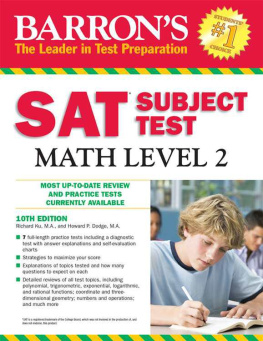
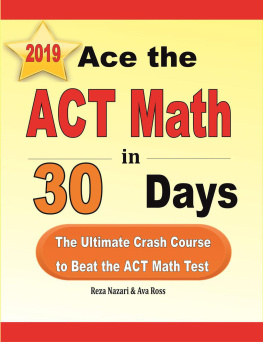
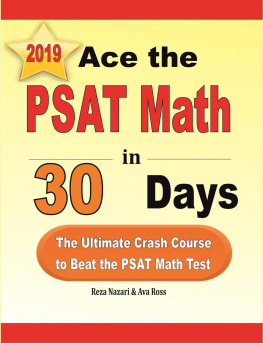
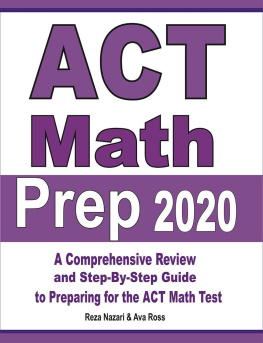
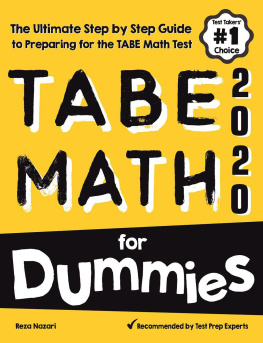
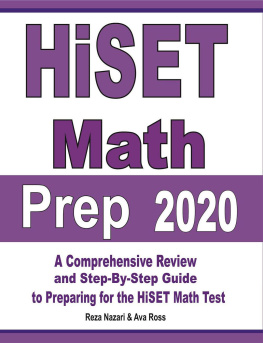
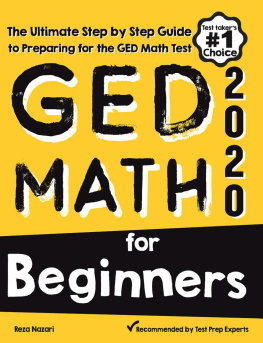

 Fill those gaps with explanations, examples, and practice problems.
Fill those gaps with explanations, examples, and practice problems.